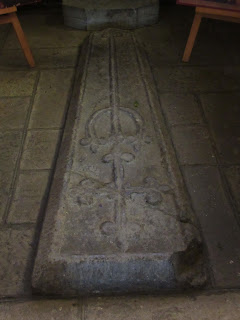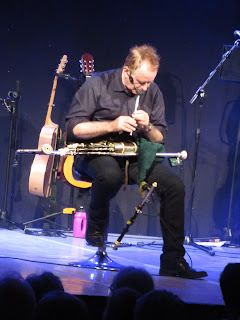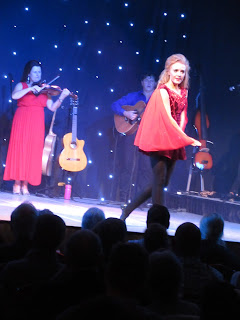Galway, located on the west coast of Ireland, was the country’s most
international city with one of every four residents born overseas. As accommodation
prices were high in and near the city, we’d chosen to stay in Claregalway north
of the city. With its pouring cats and dogs, we were in no rush to traipse
around the city so opted to take advantage of seeing Claregalway Castle and a monastery right by the hotel. The castle was closed so we walked over to the monastery instead.
In 1929, Albert Power was commissioned to sculpt a statue of Padraic O Conaire, an Irish teacher active with the Gaelic League, an organization that sought to revive Irish as a spoken and literary language. He also enrolled with the Irish Volunteers, which later became the Irish Republican Army. O Conaire is widely regarded as the first significant writer in the modern Irish language, publishing hundreds of short stories, many of which dealt with emigration and the harsh realities of rural life.
The statue was unveiled in 1935 by President Eamon de Valera who used the occasion to call for a Gaelic-speaking Ireland in the newly independent country. The sculptor hoped to reflect the nation's new cultural and political hopes. These political ideals supported the replacement of statues symbolizing the control of the British Empire with familiar ones representing a movement towards a uniquely Irish identity.
The most popular landmark in Galway has welcomed people from across the world. Many a marriage proposal has happened in his presence. The statue had spent 64 years in four separate locations in Eyre Square until it was decapitated in 1999 which sparked huge public outrage. At the subsequent trial, the presiding judge equaled the crime to the Mona Lisa being stolen from the Louvre in Paris!
The 14 colorful flags that lined the top of the square represented each of Galway's original Norman founding tribes.
The fleur-de-lis on the column was a possible mason's mark. What made our visit to the church so interesting for me was it had been like going on a Scavenger Hunt trying to find most of the 21 unique items described in the church pamphlet! I appreciated the time someone had taken to ferret out details about the church we would never have known to look for ourselves.
The Franciscan friary was founded in the first half of the 13th century probably by an Anglo-Saxon lord. As with many monasteries during the Middle Ages in Ireland, the church and where the friars lived and worked were located around a central courtyard.
The community of friars was forced to leave when, as part of Henry VIII's policy of dissolving the monasteries, the buildings and land of the friary were given to Sir Richard Bourke in 1570. Franciscan friars remained in the vicinity, however, for the next two centuries, occasionally re-occupying their old buildings.
The only way of exploring the monastery was climbing over the steps like this!
The cemetery with the castle in the background:
What an unexpected treat it had been to wander around the ancient monastery by ourselves and imagine the lives lived there so long ago.
Naomi: I am sure you and Joel would have loved to take advantage of the opportunity to participate in a Sunday afternoon of dancing in Claregalway had you also been there.
When we have a chance, I hope Steven and I will try and see documentaries or films such as The Magdalene Sisters and Philomena that highlight the plight of 19th century unmarried, pregnant, Irish women who were jailed and forced to work as virtual slaves. As a Catholic, I am appalled that various Church orders operated these notorious ‘Magdalene Laundries’ in Galway and throughout Ireland because they considered premarital sex one step short of prostitution. Naturally, no stigma was applied to the men involved! It was sad that an easy to miss modest statue downtown was what remained on the site of one of the laundries that had been operated by the Sisters of Mercy.
The laundries opened in 1824 with a capacity for 110 women and didn’t close until 1984 when 18 inmates were still there. It’s thought that more than 10,000 women were part of the Magdalene laundry system. The survivors of that horrific era in Irish history have declared they were held against their will, forced to work without remuneration, were physically abused and that their children were sold for adoption.
How disgraceful the Irish government waited until just six years ago to apologize for turning a blind eye to the women’s mistreatment.
Just a few blocks away, smack dab in the middle of Galway,
was Eyre Square named for the mayor who gave the spot to the city in 1710. In
the Middle Ages, the park was a field right outside the town wall. It was a
hopping place with lots of people just hanging out enjoying the beautiful day
after the morning rain and gloom had disappeared.
The most popular landmark in Galway has welcomed people from across the world. Many a marriage proposal has happened in his presence. The statue had spent 64 years in four separate locations in Eyre Square until it was decapitated in 1999 which sparked huge public outrage. At the subsequent trial, the presiding judge equaled the crime to the Mona Lisa being stolen from the Louvre in Paris!
The rust-colored ‘Hooker’ sculpture, built in 1984 to
celebrate the 500th anniversary of Galway’s incorporation as a city. The sails
represented the city’s square-rigged fishing ships called hookers and the
vessels that made Galway a trading center so long ago.
All that remained from a 1627 fortified townhouse was
the Browne Doorway, a reminder of the 14 family tribes that once
controlled the town. The door was erected in the square in 1905 as a ''witness
to the architectural character of the great houses that were built in the days
of Galway's civic opulence."
Also in the large park was a bust to JFK that was erected in
honor of the Irish-American president’s visit in 1963 when he spoke in front of
the adoring Irish a few months before he was assassinated.
The main street in town was Williams Gate which led from the
top end of the square and was named for the old main gate of the Norman town wall
that once was there. The statues honored Irish writer Oscar Wilde and Estonian writer Eduard Wilde who wrote about the importance of a nation's literature.
A few blocks down the busy thoroughfare was the 15th century Lynch Castle although we had difficulty recognizing it as a castle because of its simple exterior. The fortified townhouse had been the home of the Lynch family, the most powerful of the town’s 14 tribes, and was the only home to survive. It was staggering to think more than 80 mayors who governed Galway in the 16th and 17th centuries were from the Lynch family!
One of my favorite spots in Galway turned out to be the Collegiate Church of St. Nicholas that was built in 1320 on the site of an earlier chapel and was dedicated to St. Nicholas of Myra now in Turkey, the patron saint of sailors. It’s believed that Columbus worshipped here in 1477 not too long before he sailed the ocean blue. He may have been inspired by St. Brendan the Navigator, an Irish monk who is thought to have sailed to America in the 6th century!
Two sides of the late 16th century font were carved with
designs similar to the windows in the church.
The large cross was a memorial to parishioners who died
during the First World War.
Banners hanging by the entrance to one of the chapels were
from an army division that formed in 1793 and fought during the 1808-1814 Peninsular
War as part of the Napoleonic Campaign.
Vocational gravestones on the floor bore the symbols of the
deceased’s occupation: three crowned hammers for the mark of a goldsmith; a dog
on a lead and a pair of shears were the mark of a wool merchant. Others were
the marks of a cooper or carpenter and a tailor. When the church was renovated,
300-400 skeletons were found in a mass grave in this area.
The late 15th century Holy Water Stoup was one of the church's most unusual features because it was normally built into the church wall rather than being freestanding.
Above the pulpit was the carving of a manticora – a half man,
half lion whose knotted tail indicated a defeat of the devil.
The 13th or 14th century Crusader's Tomb was the oldest tomb in the church and may have come from a nearby chapel of the Knights Templar which was destroyed in 1324.
Nearby was a long 16th century gravestone that looked like it had angel wings although it was actually called 'Celtic Revival' interlace! Tombs' faces were often defaced by Cromwellian forces in 1652.
The Apprentice’s Column differed from the other ones because its name came from the tradition that an apprentice mason had to produce a ‘master-piece’ before he could become a craftsman.
I didn’t notice until we left the entrance a series of animal gargoyles
intended to throw water off the roof.
We continued our lazy stroll down Williams Gate, passing The Quays, a pub once owned by Humanity Dick, an 18th century Member of Parliament known for being an animal rights activist. His work led to the world’s first conviction for cruelty to animals in 1822!
The pedestrian mall was known as the Latin Quarter but that seemed
like a clever marketing ploy more than anything based in reality from what we could
see!
At the end of the tourist gauntlet was Wolfe Tone Bridge
over the River Corrib. I never did figure out while we were in Ireland why the
name of the river always came at the end! Likewise, County Galway and not
Galway County! The river was running incredibly quickly - it would have been very dangerous if anyone had fallen in.
A monument closest to the bridge had been given to the city
by the city of Genoa, Italy, to celebrate the 1477 visit here of Cristoforo
Colombo or Christopher Columbus as we know him.
Across the river was a modern housing project that replaced Claddagh,
a picturesque Irish-speaking fishing village from the 1930s. The village had a
strong tradition of independence with its own ‘king’ until the early 1900s.
Spanish Arch, overlooking the River Corrib, was the best remaining
chunk of the old city wall. It was where Spanish ships would offload their
cargo, mostly wine.
That evening we attended Trad on the Prom, a concert of traditional Irish or 'trad' music located on the Prom or Promenade, a short distance from downtown Galway. It showcased the amazing talents of Galway native Mairin Fahy, the featured soloist on fiddle and vocals with Riverdance and The Chieftains. Joining her was Chris Kelly, the guitarist/creative director and emcee who did a marvelous job welcoming the audience in a variety of languages.
The musician in the middle, Yvonne Fahy, was a musical virtuoso playing the uileann pipes. We'd first been been introduced to the halting music played on the uileann pipes at a concert in Dingle Dingle about a week previously. She later played the banjo, accordion, the whistles - you named it, she played it!
Watching the step dancers a little later was like poetry in motion -they just floated!
An absolute joy to watch was Cathal Keaney who had won the World Championships title for the last two years after beginning dancing at just five. He'd won every major title in one year there is in Irish dancing, a remarkable feat known as the grand slam in Irish dancing! Cathal, in his spare time, is studying engineering, figuring his body surely can't withstand the punishing demands Irish dancing puts on it.
The caliber of the musicianship was taken up a notch even further when Gerard Fahy, the musical director and composer for Lord of the Dance and its sequel, began playing the uileann pipes.
Chris Kelly, the emcee, then introduced the next act, two young men who had recently competed in a nationally televised show akin to America's Got Talent. He said there were 1,000 acts to begin with who were then pared down to 54 who competed. The winners were these two; the one on the right was his son! I could have watched them and the other dancers all night long, they were so incredibly talented.
We then had the delight of watching the staggering six-time World Irish Dance Champion, Claire Greaney, perform.
Yvonne accompanied Claire on the bodhran, an Irish frame drum, one of a small family of Celtic instruments that is believed to pre-date Christianity.
Chris then invited Marc Roberts who was in the audience to join him and the other musicians on the stage. Roberts came to worldwide notice when he represented Ireland in the Eurovision Song Contest. He is now one of Ireland's leading songwriters and has released three highly acclaimed solo albums.
The level of talent and professionalism from the moment we sat down until we regretfully had to leave was outstanding. The excellent music mixed in with world-class Irish dancing was out of this world. If you're ever traveling to Galway from May to September, make sure to get tickets to Trad on the Prom, you won't be disappointed.
Next post: Ferry over to Inishmore, the largest of the three Aran Islands.
Posted on October 11, 2019, from our home back in the Denver suburb of Littleton, after a wonderful six week trip mostly to Ireland but also parts of the United Kingdom.






























































































I've never heard of the "uileann pipe". Looks interesting. Janina
ReplyDelete